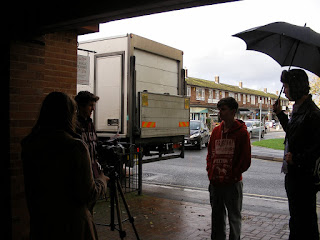Lighting
Image Colour
The bright colours of the character's clothing in the image sets a positive impression on the audience relating to the themes of the program. This is enhanced by the central lighting, as discussed above.
Font
Channel 4 always uses a constant font in the graphics for all of their print adverts. This is a font which was purposely created for Channel 4 to use on their own Television Advertisements (for content due to be aired on Channel 4) and for their print adverts in newspapers, magazines and print advertisements. The idea of having a constant font such as the one used above is to help engineer and promote a brand identity. The name of the font is 'C4'.
In this case, the font colour is relevant because of the program's title, 'This is England '86' relating to the colours of the English flag, which are red and white. These also blend in to the bright colours seen in the Image.
Sponsor
Not all of channel 4's print advertisements have a sponsor, although when they do, their logo appears in the top left corner of any print advertisement. This is so that the sponsor does not distort too much of the message promoting the program relating to scheduling, the image, and the Channel 4 logo.
Logo
The logo will always appear on the central right corner. Again, this is to help promote the brand identity and the program being advertised. In the case of this advertisement, some of the logo is transparent, although in many other advertisements for other programs, this area is black. There will always be white areas in channel 4's logo. The logo never:
- is distorted
- is placed inside a box or frame
- contains text inside the '4'
- has tone added to areas where the white is supposed to be
- has an outline sounding the '4' logo
There will never be more than three levels of a typographic hierarchy. The first line will contain a strap line (not always included), the second the title, and on the third line, the scheduling information including the date and time. In the case of the print advert above, there are only two lines. This is the title of the program, strap line and the scheduling information. The later two of the three have been mixed into the second line at the bottom.
Typographic Flexibility
Channel 4 allow some for some flexibility relating to the location of the typography. Although many of them appear on the bottom left hand side, it is allowed to appear in the top left and also central left. This is providing that the logo and image advertised is not being covered up by the typography.
These are some other examples of print advertisement which were made for Channel 4:































